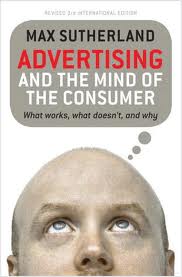Advertising and the Mind of the Consumer

– By Max Sutherland
I had read the first edition of Advertising and the Mind of the Consumer over ten years ago and it made a huge impact to me at the time.
Max Sutherland is a marketing psychologist who has been tracking the effects of advertising communication for many of the leading global advertisers and has used his researches to write, what I think, is a compelling book. I would strongly advise marketing and advertising professionals to go through it.
Let’s face it – most of us just don’t seem to have a very clear idea of how advertising works. And I am even including seasoned marketers and advertising people in this list. Advertising has this mystique about it (and that had worked hugely in favour of the industry) and most marketers do not really question the effectiveness of their ad campaigns. Except to mention, wryly I am sure, that ‘I know that half my advertising is wasted – but I don’t know which half!’ This mystique has also allowed many ad agencies to sell totally ineffective campaigns to their clueless clients. Sutherland, given his background, has used marketing research – especially continuous tracking of ads – to present his insights. In the bargain, he has tried to demystify the effects of advertising.
The book is divided into two sections – Why Advertising Has Stayed a Mystery for So Long and What Works, What Doesn’t and Why. Some key insights from the book:
1. It is difficult to introspect on advertising and how it influences us because we look for major effects from it. This happens only if the advertiser has something new to present. In reality, most advertising has subtle, minor effects. And most effects of advertising fall well short of persuasion. In reality, most advertising acts like feathers rather than heavy weights.
2. Repetition of an ad is important because the small effects add up to something significant overtime. Repetition of a claim also increases our familiarity with it and can have the ‘truth effect.’
3. Many advertisers look at how advertising influences the consumers’ evaluation of a brand. In reality, much of advertising’s influence is not on the evaluation of brands but on the order in which alternate brands are evoked. This is the ‘agenda setting effect’. That is why brand salience is so important.
4. Subliminal advertising that people fear and have attacked is a hoax. On the other hand, subtle effects that are not hidden from the consciousness are likely to have a bigger impact.
5. People generally go with what the majority of people think and do – the ‘bandwagon effect.’ Advertising makes the brand appear popular and the more a brand is advertised, the more popular it is perceived to be.
6. Just because consumers are sometimes (especially when they see image advertising) unable to play back an ad’s key take-out, that does not imply that the ad is ineffective. ‘Communication of impressions can be just as effective as communication of facts.’
7. Product placements are pretty commonplace these days. However, while very effective, it has taken advertisers and ad agencies a long time to understand their value. And that is because product placements do not provide explicit messages. Yet, subtlety is powerful in advertising.
8. The effect of advertising is more often not persuasion but reinforcement.
9. Static, one time snapshot researches are not as effective as continuous tracking. Many new product launches fail because the same care that is given during the pre-launch stage is not given after the ‘go’ decision. Continuous tracking to monitor key measures like awareness, trial and repeat purchase is very important; else, we are likely to pull the plug too early.
10. Stopping advertising for whatever reasons can be dangerous. That is because it may take months before the effect on sales is visible. If the brand franchise erodes, it may take a long time to get back on track.
11. Brand focussed measures can tell us better if an ad is working rather than ad focussed measures. Brand focussed measures measure performance and associations with the brand. Ad focussed measures, on the other hand, aid the diagnosis of ads, especially when they are not working.
I have just touched upon some of the points raised in Sutherland’s excellent book. He is a strong proponent of continuous tracking of brands and ads and almost the entire second section of the book looks at the way to do continuous research and to draw relevant conclusions from the findings of these researches.
Sutherland has brought some practicality into the understanding of advertising on the basis of research. In the bargain, he has, too a large extent, succeeded in demystifying advertising.
Rating: A+
